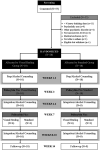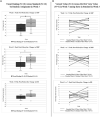Nature-themed video intervention may improve cardiovascular safety of psilocybin-assisted therapy for alcohol use disorder
- PMID: 37795513
- PMCID: PMC10545868
- DOI: 10.3389/fpsyt.2023.1215972
Nature-themed video intervention may improve cardiovascular safety of psilocybin-assisted therapy for alcohol use disorder
Abstract
Introduction: Psychedelic-assisted therapy with psilocybin has shown promise in Phase 2 trials for alcohol use disorder (AUD). Set and setting, particularly factors facilitating a connection with nature, may positively influence the psychedelic experience and therapeutic outcomes. But to date, randomized controlled trials of interventions to enhance set and setting for psychedelic-assisted therapy are lacking.
Methods: This was a pilot randomized, controlled trial of Visual Healing, a nature-themed video intervention to optimize set and setting, versus Standard set and setting procedures with two open-label psilocybin 25 mg dosing sessions among 20 participants with AUD. For the first session, participants randomized to Visual Healing viewed nature-themed videos during the preparation session and the "ascent" and "descent" phases of the psilocybin dosing session while participants randomized to the Standard condition completed a meditation during the preparatory session and wore eyeshades and listened to a music playlist throughout the dosing session. For the second session 4 weeks later, participants chose either Visual Healing or Standard procedures. Primary outcomes were feasibility, safety, and tolerability of Visual Healing. Secondary and exploratory outcomes were changes in alcohol use, psychedelic effects, anxiety and stress.
Results: Nineteen of 20 (95%) randomized participants (mean age 49 ± 11 years, 60% female) completed the 14-week study. During the first psilocybin session, participants viewed an average of 37.9 min of the 42-min video and there were no video-related adverse events. Peak increase in post-psilocybin blood pressure was significantly less for participants randomly assigned to Visual Healing compared to Standard procedures. Alcohol use decreased significantly in both Visual Healing and Standard groups and psychedelic effects, stress, and anxiety were similar between groups.
Discussion: In this open-label pilot study, viewing Visual Healing videos during preparation and psilocybin dosing sessions was feasible, safe, and well-tolerated among participants with AUD. Preliminary findings suggest that Visual Healing has potential to reduce the cardiovascular risks of psychedelic therapy, without interfering with the psychedelic experience or alcohol-related treatment outcomes. Studies to replicate our findings as well as studies of different set and setting interventions with other psychedelic medications and indications are warranted.
Keywords: alcohol use disorder; nature therapy; psilocybin; psychedelic-assisted therapy; set and setting; video interventions.
Copyright © 2023 Heinzerling, Sergi, Linton, Rich, Youssef, Bentancourt, Bramen, Siddarth, Schwartzberg and Kelly.
Conflict of interest statement
KH, DK, and LS are inventors for a provisional patent application by Pacific Neuroscience Institute Foundation for a video-based set and setting intervention. KH, KS, ML, and DK receive clinical trial support from Usona Institute. DK has stock in MindMed, Numinus, and Noetic Fund. KH is a consultant for MindMed. KS is a consultant for Field Trip Health and has stock in Compass Pathways, Field Trip Health, and MindMed. Author LS was employed by company Moving Art. The remaining authors declare that the research was conducted in the absence of any commercial or financial relationships that could be construed as a potential conflict of interest.
Figures




Similar articles
-
Percentage of Heavy Drinking Days Following Psilocybin-Assisted Psychotherapy vs Placebo in the Treatment of Adult Patients With Alcohol Use Disorder: A Randomized Clinical Trial.JAMA Psychiatry. 2022 Oct 1;79(10):953-962. doi: 10.1001/jamapsychiatry.2022.2096. JAMA Psychiatry. 2022. PMID: 36001306 Free PMC article.
-
Therapeutic Alliance and Rapport Modulate Responses to Psilocybin Assisted Therapy for Depression.Front Pharmacol. 2022 Mar 31;12:788155. doi: 10.3389/fphar.2021.788155. eCollection 2021. Front Pharmacol. 2022. PMID: 35431912 Free PMC article.
-
Single-dose psilocybin therapy for alcohol use disorder: Pharmacokinetics, feasibility, safety and efficacy in an open-label study.J Psychopharmacol. 2025 May;39(5):463-473. doi: 10.1177/02698811251319457. Epub 2025 Feb 28. J Psychopharmacol. 2025. PMID: 40018886 Clinical Trial.
-
Psychedelic-assisted treatment for substance use disorder: A narrative systematic review.Addiction. 2025 Jan 30. doi: 10.1111/add.16762. Online ahead of print. Addiction. 2025. PMID: 39887551 Review.
-
Psychedelic Therapy: A Primer for Primary Care Clinicians-Psilocybin.Am J Ther. 2024 Mar-Apr 01;31(2):e121-e132. doi: 10.1097/MJT.0000000000001724. Am J Ther. 2024. PMID: 38518269 Review.
Cited by
-
Psychedelics for Alcohol Use Disorder: A Narrative Review with Candidate Mechanisms of Action.CNS Drugs. 2025 Sep;39(9):843-864. doi: 10.1007/s40263-025-01199-z. Epub 2025 Jul 10. CNS Drugs. 2025. PMID: 40640527 Review.
-
What are set and setting: Reducing vagueness to improve research and clinical practice.J Psychopharmacol. 2025 May 26:2698811251337372. doi: 10.1177/02698811251337372. Online ahead of print. J Psychopharmacol. 2025. PMID: 40415530 Free PMC article.
-
Psilocybin: From Psychiatric Pariah to Perceived Panacea.Am J Psychiatry. 2025 Jan 1;182(1):54-78. doi: 10.1176/appi.ajp.20230682. Am J Psychiatry. 2025. PMID: 39741437 Review.
-
Adverse Events in Studies of Classic Psychedelics: A Systematic Review and Meta-Analysis.JAMA Psychiatry. 2024 Dec 1;81(12):1225-1235. doi: 10.1001/jamapsychiatry.2024.2546. JAMA Psychiatry. 2024. PMID: 39230883
-
Validation of the imperial psychedelic predictor scale.Psychol Med. 2024 Sep 27;54(12):1-9. doi: 10.1017/S0033291724002204. Online ahead of print. Psychol Med. 2024. PMID: 39327922 Free PMC article.
References
-
- Bogenschutz MP, Ross S, Bhatt S, Baron T, Forcehimes AA, Laska E, et al. . Percentage of heavy drinking days following psilocybin-assisted psychotherapy vs placebo in the treatment of adult patients with alcohol use disorder: a randomized clinical trial. JAMA Psychiat. (2022) 79:953–62. doi: 10.1001/JAMAPSYCHIATRY.2022.2096 - DOI - PMC - PubMed

